Why French Cooking Still Matters Mightily

Steamed croacker (fish) in nasturtium juice at Clover
Released this week, The Michelin 2015 Guide to France attests to the good health of gastronomy in Gaul as a talented new generation of chefs are slowly acknowledged by the august institution. Among the stand-out awards were three stars to chef Yannick Alleno at Ledoyen and a star to chef David Toutain for his eponymous restaurant, both in Paris, and a star to chef Albert Riera at Le Jardins des Plumes in Giverny. So it seemed an opportune time for a little musing on the state of French cooking right now.
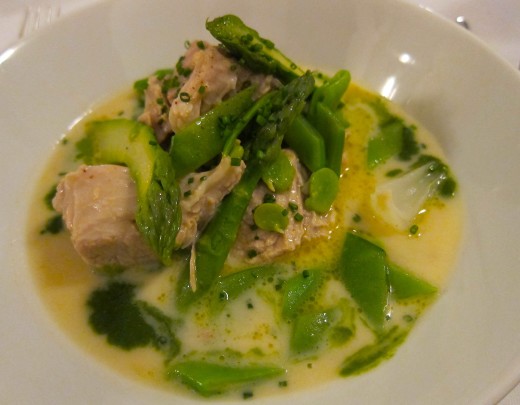
Blanquette de veau at Semilla
Ever since gastronomy, which is what cooking and eating are called when they’re done as much for pleasure as for nourishment, stopped being a uniquely aristocratic pleasure and went mainstream during the 19th century, cooking in the western world has spun on a Gallic axis. This is because the epicurean culture of France, a country with one of the world’s most prodigiously blessed larders, was lavishly codified in terms of those calibrated instructions we call recipes long before the same precisely scored orchestration of culinary techniques occurred in most other European countries.
And well beyond the refined dishes that were originally concocted in chateaux kitchens, a profound love of great food and wine has always permeated French society and the country’s self-identity. The French phrase, ‘Les arts de vivre’ (the arts of living), among which is good cooking, conveys the deep seriousness with which the French shop for food, cook and consume it, and talk and think about it, which they do constantly and with real erudition.
This passionate devotion to gastronomy doesn’t look set to be changing anytime soon, and as an American who’s lived in France for almost thirty years, I have no doubt France will continue to be the ultimate culinary reference for the West and, sometimes beyond, since no country in the world has a deeper respect for French produce, technique and culinary prowess than Japan, for a longtime to come.
Why? Aided and abetted by a quiet revolution in Gallic gastronomic media in all forms—newspaper columns, guidebooks, television shows, websites, and magazines, French cooking has been the object of a typically subtle but ever accelerating renaissance which began well before I arrived in 1986 with that unjustly maligned sequence of brilliant experiments and culinary innovations known as “La Nouvelle Cuisine.”
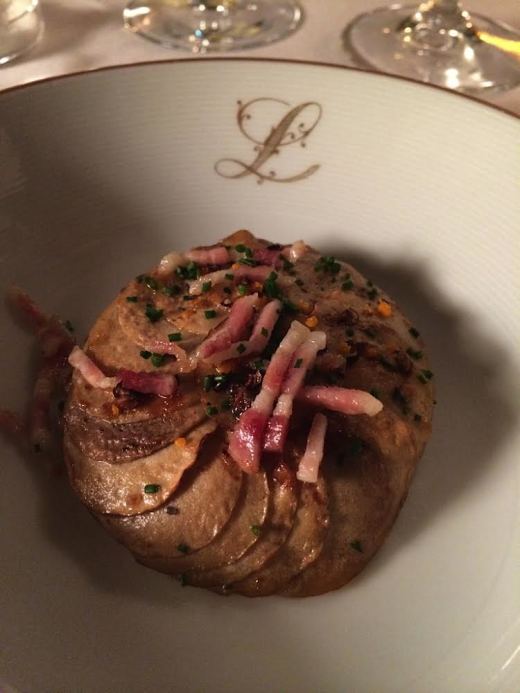
Chef Yannick Alleno’s stuffed cep at Ledoyen
But wait. What about all of those articles about how French food has become lousy, and the kerfuffle around the recently announced ‘Fait Maison’ (House Made’) label, which has been created to indicate that a French restaurant is serving food that’s actually been cooked on the premises rather than stuff bought from an industrial caterer? Doesn’t this mean French food has hit the skids? And what about the French passion for McDonald’s (France is one of the largest and most lucrative markets for the American burger titan)? And the decline of French raw milk cheese production, and the fact the majority of the French now do their shopping in the kind of vast neon-lit hangar-like supermarkets so woefully familiar to Americans.
Well, yes, France has changed, and so have we. But what’s perhaps changed more than anything else is the way the western world perceives of French cooking, which is through an enthusiastic but erroneous prism of schadenfreude. To wit, those arrogant Frogs were always a bit too fancy, a bit too big for their britches, so let them eat floppy factory baguettes instead of cake now that we’ve got some good really food in our own country and theirs isn’t the best—whatever that might mean–anymore.
Of course, the real story—the quiet one, is much more layered and nuanced than all that. Let me begin to explain by recalling a long ago visit to Paris with my brother. For reasons I no longer remember, we decided to visit the Chateau de Vincennes during a weekend in Paris from London on a blustery February morning some thirty years ago. Following a long Metro ride, we got soaked wandering around this imposing but melancholy medieval fortress in suburban Paris. Even as supremely dutiful tourists hoping to impress ourselves and those who’d listen to tales of our travels back home by going off the beaten track in Paris, the problem was we lacked enough history to appreciate or imagination to animate the old stones, especially since that morning we were both worse than wooly headed after an enthusiastic first discovery of Armagnac in a cafe the night before. So finally we threw in the towel on anything erudite and went across the street for lunch in a restaurant in a faux half-timbered building with rippled amber panes in its front windows.
We were wearing rain-soaked ski jackets and jeans, as I recall, but Madame la proprietaire received us like lost Counts, which immediately set us up for a good meal by making us feel welcome and even a little important. Small warm flakey buttery pinwheels of pastry filled with smoked salmon arrived unbidden after we’d decided that, well, yes, of course we’d have a glass of Champagne before lunch. And just after the bubbles had balmed our spirits, a wispy breeze started to tease us even before our first course reached the table, since the fine feral perfume of chopped black truffle in a fluffy yellow blaze of scrambled egg invisibly proceeded the actual dish. Our first truffles! And this as part of a modestly priced prix-fixe lunch menu in a randomly chosen restaurant.
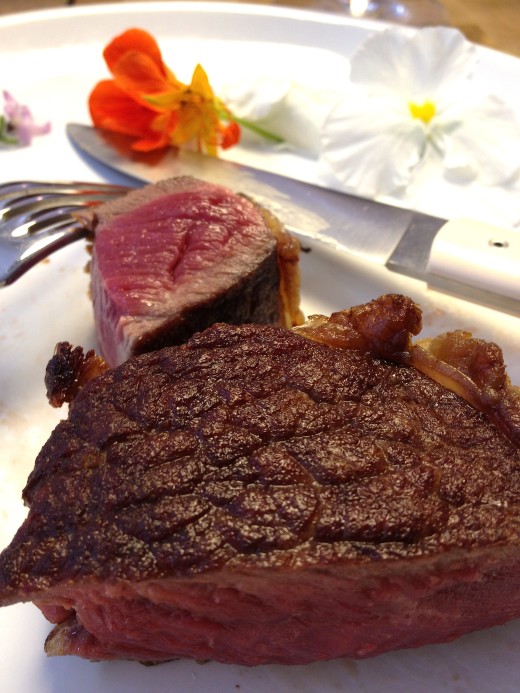
Steak at Restaurant Hugo Desnoyer
Then we ate veal Marengo, the dish created for Napoleon after he’d won a battle with the Austrians near the battle of Morengo in northern Italy in 1800. Hearty, savory, and saucy, the stew of tender veal braised with tomatoes, mushrooms, onions, white wine and herbs was obviously a general’s feed, and its taste thrilled us as much as its history. Next a vast willow cheese tray that creaked under the weight of its contents when the proprietress rested an edge on the table and tipped it towards us. Knowing nothing about cheese, we both randomly pointed at a few, and scored a couple of fabulously funky mouthfuls. And finally, a big bowl of chocolate mousse arrived, and clearly enjoying our puppy-like pleasure in the meal, the owner, a middle-aged lady with softly waved meringue colored hair and glasses on a filigreed resting on her abundant bosom, offered us both a little pour of vieille prune.
This meal left us elated, as did a big dented aluminum tray of freshly shucked oysters on crushed ice and a bottle of Muscadet in a brasserie across the street from the Gare du Nord the next day, and even if we went our separate ways—me back to London and then New York, my brother to Greece, we shared the troth that French food was something remarkable, even transcendental. But then what did we, or almost any other American baby boomer who wasn’t born of first generation immigrant parents, know about food in those days when Parmesan cheese for the few Americans who’d even heard of it came as a sharp powder in a green metallic tube, salad meant iceberg lettuce with bottled dressing, and cakes were made from mixes with a smiling lady with a perky brown bob in a medallion on the front panel.
Then, slowly, all things edible started to change in the United States and most of the other English-speaking countries, as a new generation slowly became interested in gastronomy, and not just French dishes with fancy sauces, but Spanish paellas and the various regional kitchens of Italy—as opposed to the garlicky red sauce version of this country’s cooking that had been billed as ‘Italian’ the world over for a very longtime outside of its borders, and even ‘real’ Mexican and Indian food. Other kitchens suddenly became part of the middle-class vernacular, too—Thai, Japanese, even Moroccan.
Meanwhile in France, the country continued its post-war fascination with a Gallic take on an American lifestyle based on the two words that have become the most common coffin nails of good cooking anywhere—“modernity” and “convenience.” During “Les Trente Glorieuses,” as the French called the thirty years of prosperity that ran roughly from from 1945 to 1975, the French middle class suburbanized and began shopping in the new supermarkets in the dozens of malls that were built to service the housing developments that came to ring many French cities. Americans like my brother and myself knew nothing about this evolution of the French diet, however, since we came to France to verify the Grand Tour adage “You can’t get a bad meal in Gaul” with expectations amped up by the new flutter about French food Julia Child was making in affluent American suburbs.
It took a while for the news to really register in the U.S., but at the same time Mme. Child was rightfully extolling the glories of boeuf bourguignon and blanquette de veau, serious change and bold but brilliant reasoned innovation was already afoot in French gastronomy. Reacting to the gastronomic excesses of post-war affluence and the prevailing boilerplate of Auguste Escoffier and his five mother sauces, a new generation of French chefs, including Alain Chapel, Jean and Pierre Troigros, Michel Guérard and Roger Vergé began writing a new chapter in French cooking.
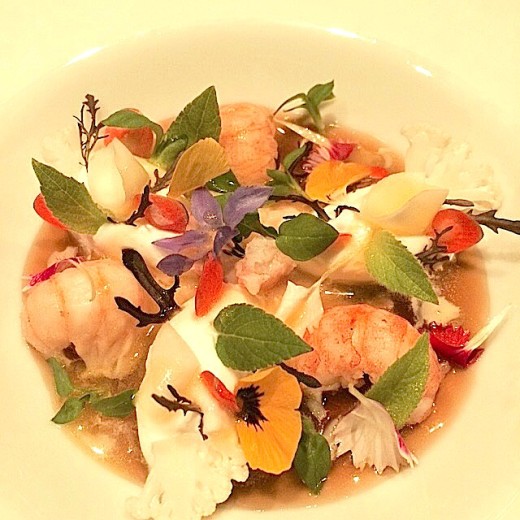
Crayfish salad with anise gelee at Hexagone
What ultimately came to be known as “La Nouvelle Cuisine” espoused dramatically shorter cooking times to preserve the natural flavors of foods, championed the freshest seasonal produce, and rejected heavy dairy or flour based sauces in favor of jus (reduced or concentrated juices), fresh herbs, lemon juice and vinegar. New cooking methods and tools, including the microwave, were embraced, and 20th century cuisine bourgeoise was politely side stepped by chefs who drew inspiration from traditional regional dishes, which they configured in new ways in terms of both taste and presentation.
It began so well, but then it suddenly became the object of ridicule in food magazines and restaurant columns all over the world. What made it an easy target were its aesthetics, notably its modest portions, which set it up as effete, mannerist and deeply unsatisfying, or everything the English-speaking world ever instinctively believed about French gastronomy, bis. So La Nouvelle Cuisine was mocked and discredited and ultimately sworn off by many French chefs, who affirmed the holy grail of Escoffier, or the kind of classical French cooking that had always worked so well as both Michelin Guide and tourist bait.
The thing is, though, that the basics of this modern kitchen not only never went away, but became even more important as a subsequent generation of chefs, notably Yves Camdeborde, Thierry Faucher, Thierry Breton, and others, assiduously applied them to bistro cooking. In doing so, they completely reconfigured the gastronomic landscape of France, so that the country’s globally adored bistro cooking is now served in versions traditional or modern, the later style meaning it’s informed by the precepts of La Nouvelle Cuisine. Short take: France has been rebooting its brilliant cooking for the last forty some years, and without this new Gallic thinking, the ground-breaking gastronomy in Spain or Scandinavia could never exist.
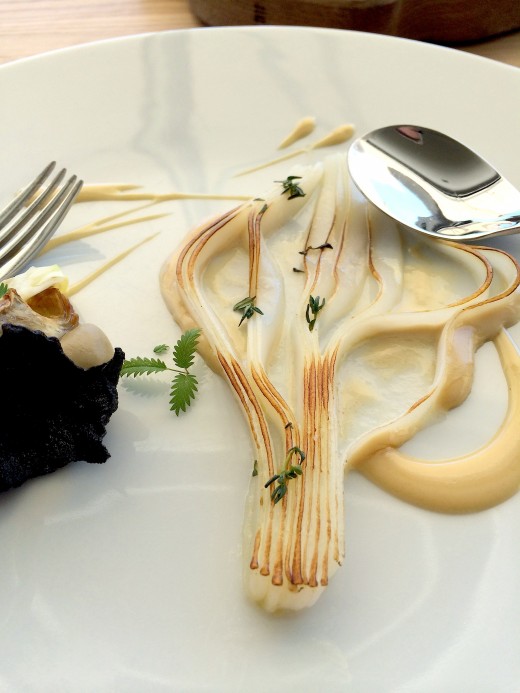
Squid carbonara at Mirazur, Menton
Against the backdrop of this relentlessly questing and innovative avant-garde cooking, however, the thing that’s confused everyone about France today is that the silhouette of the basic conversation about food and cooking has become more or less the same as it is in any other rich western country. The United States has Alice Waters and Blue Hill Farms on the one hand and Paula Dean and the Cheese Cake Factory on the other. You could pretty much parse out France the same way today, too, and in both countries the power that huge international food and packaged goods companies has over what we eat is nearly crushing, or it would be if an ever louder public debate about good cooking and healthy food hadn’t begun to force enormous changes on the food chain everywhere.
So France isn’t Oz anymore, but then maybe it never was. In fact I suspect there’s always been some really lousy food to be had in France (see George Orwell “Down and Out in London and Paris” etc.), that is if you knew where to find it. But is there any another western country that’s so brilliantly reinvented much of its restaurant offer over the course of the last forty some years in favor of cooking that’s better, healthier, more cosmopolitan, more creative, and more interesting? I don’t think so. And abetted by what just may be the world’s best transportation system and a growing preference for rural rather than urban living, there’s also no place you’ll find so many spectacularly talented young chefs in the ‘middle of nowhere.’ In fact it’s probably truer today that you can’t get a bad meal in France if you have your wits about you than it’s ever been.
And if the country has wrong footed itself with crackpot schemes like the thirty-five-hour work week, which threw the door wide open to every industrial culinary short-cut you can imagine, because restaurants suddenly saw their already modest profit margins become nearly transparent, no country sustains a more ferocious public conversation about the quality of its food and its gastronomic menaces and failures than France.
As the fantasy of American style ‘modernity’ and ‘convenience’ reveals itself to have been a destructive mirage, the French are returning to their traditional food ways with a rightfully proud vengeance, too. This is why the country has so many different labels that help consumers identify regional produce, traditionally raised produce, organic produce and other measures of quality. And since France still has the world’s best produce, its most exigent system of professional culinary education, and gastronomically literate public, the fifty-year long renewal of the French kitchen solidly assures the country’s ancient role as the ballast of and most exacting arbiter of western gastronomy. France may no longer be the epicurean Mount Olympus it was once perceived to be, but this is mainly because its been so successful at teaching the rest of the world that good food not only really matters, but is essential to any happy healthy life.




